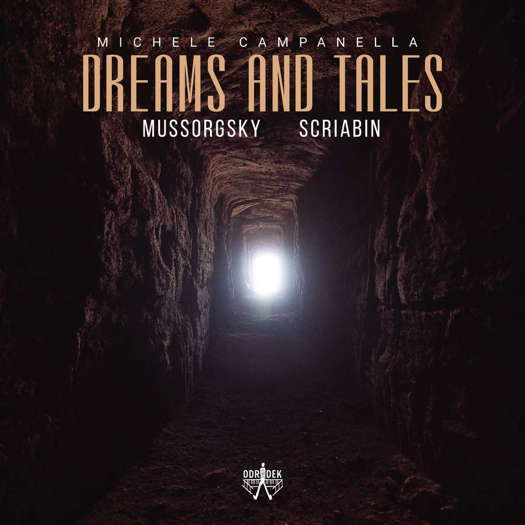 WORD SEARCH: Can you solve Allan Rae's classical music word search puzzles? We're currently publishing one per month.
WORD SEARCH: Can you solve Allan Rae's classical music word search puzzles? We're currently publishing one per month.
- Norwegian
- Sisyphe
- Leopold Auer
- Bruckner
- Sarah Leonard
- Mozart: Lo Sposo Deluso
- Andong Culture & Arts Center
- Worcester Festival Choral Society
 SPONSORED: Ensemble. Melting Rhapsody - Malcolm Miller enjoys Jack Liebeck and Danny Driver's 'Hebrew Melody' recital, plus a recital by David Aaron Carpenter.
SPONSORED: Ensemble. Melting Rhapsody - Malcolm Miller enjoys Jack Liebeck and Danny Driver's 'Hebrew Melody' recital, plus a recital by David Aaron Carpenter.
All sponsored features >>

Dreams and Tales
GIUSEPPE PENNISI listens to piano music by Musorgsky and Scriabin played by Michele Campanella
'... the different touch from previous renderings makes this CD very well worth listening to.'
On 20 November 2020, this magazine published a review of a CD by the accomplished Italian pianist Michele Campanella, issued by the Odradek label; it dealt with three suites for solo piano by Franz Liszt. Odradek is a non-profit artist-controlled classical cooperative label and concert association. This summer, Odradek produced another Campanella CD. As with the previous recording, this deals with three very well-known masterpieces that have been often recorded by other important pianists: Modest Mussorgsky's Pictures at an exhibition and Alexander Scriabin's Sonata No 3 Op 23 and Valse Op 38. Two Russian composers with works from broadly the same period - the last decades of the nineteenth century when the Russian musical school was shaping up. The three compositions are presented under the same title: Dreams and Tales, which captures well the spirit of the three compositions because Mussorgsky's and Scriabin's works share a dreamy atmosphere whilst telling stories. The CD is in an elegant case with a booklet in English, French and Italian.
As said, these pieces are often in concert halls' repertory and they have been recorded on several CDs. The listener can choose among a large number of recordings of the original piano version of Mussorgsky's Pictures at an exhibition as well as of the transcriptions for symphony orchestra - most frequently that by Maurice Ravel. Scriabin's Sonata No 3 and Valse are not equally popular; there is, nonetheless, a large gamut of CDs to select from.
Thus, in listening to this recording it is important to focus on the specific feature to look for. Michele Campanella is Italian, or, rather, as he himself clarifies, Neapolitan. As he says: 'I am Neapolitan in spirit, by family and by schooling. I tend toward pessimism but I am saved by irony.' Thus, pessimism saved by irony are the characteristics to look for in his rendering of three scores he has been familiar with for forty years, but has decided to record only now.
Mussorgsky's Pictures at an exhibition is based on paintings by the artist, architect and designer Viktor Hartmann. It was probably in 1868 that Mussorgsky first met Hartmann. Both men were devoted to the cause of an intrinsically Russian art and quickly became friends. They likely met in the home of the influential critic Vladimir Stasov, who followed both of their careers with interest. According to Stasov's testimony, in 1868, Hartmann gave Mussorgsky two of the pictures that later formed the basis of Pictures at an Exhibition. In 1870, Mussorgsky dedicated the second song - 'In the Corner' - of the cycle The Nursery to Hartmann.
Hartmann's sudden death on 4 August 1873 from an aneurysm shook Mussorgsky along with others in Russia's art world. The loss of the artist, aged only thirty-nine, plunged the composer into deep despair. Stasov helped to organize a memorial exhibition of over four hundred Hartmann works in the Imperial Academy of Arts in Saint Petersburg. Mussorgsky lent to the exhibition the two pictures Hartmann had given him, and viewed the show in person several times. Later, Mussorgsky was inspired to compose Pictures at an Exhibition, quickly completing the score in three weeks (2-22 June 1874). The music depicts his tour of the exhibition with each of the ten numbers of the suite serving as a musical illustration of an individual work by Hartmann. The theme of a promenade links the viewing of each painting.
Listen — Musorgsky: Promenade (Pictures at an Exhibition)
(track 1, 0:01-0:35) ℗ 2021 Odradek Records LLC :
The promenade itself is, in Campanella's rendering, full of melancholy, a mature melancholy quite different from that of Franz Liszt's Years of Pilgrimage of the CD reviewed last year. Of the description of the pictures, those with more Neapolitan colours are The Old Castle, The ballet of the chickens in their shells, The Catacombs and The Great Gate of Kiev. In short, not only virtuoso but a different touch.
Listen — Musorgsky: The Great Gate of Kiev (Pictures at an Exhibition)
(track 16, 0:00-0:54) ℗ 2021 Odradek Records LLC :
Scriabin's Sonata No 3, Op 23 (1897/8), was finished in the summer of 1898 on a country estate at Maidanovov, shortly before the start of Scriabin's few years as piano professor at the Moscow Conservatoire
The Sonata is a large-scale, four-movement work. Within three years, Scriabin was to complete his first two symphonies, and this Sonata is symphonic in its polyphony, long-sighted formal construction and thematic development, breadth of phrase and heroic, epic manner. If we search for 'pessimism with irony', the key movements are the first (Drammatico) and the third (Andante).
Listen — Scriabin: Drammatico (Sonata No 3, Op 23)
(track 17, 0:01-0:57) ℗ 2021 Odradek Records LLC :
Listen — Scriabin: Andante (Sonata No 3, Op 23)
(track 19, 0:00-0:56) ℗ 2021 Odradek Records LLC :
Scriabin's Valse is much later composition (1904) with a Romantic flavour. On this CD, Campanella makes it engrossing.
Listen — Scriabin: Valse
(track 21, 5:07-5:59) ℗ 2021 Odradek Records LLC :
In short, the different touch from previous renderings makes this CD very well worth listening to.
Copyright © 16 October 2021
Giuseppe Pennisi,
Rome, Italy

CD INFORMATION: MICHELE CAMPANELLA - DREAMS AND TALES


